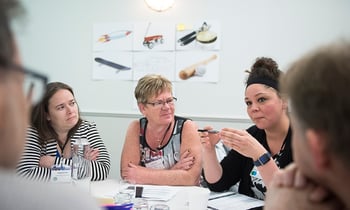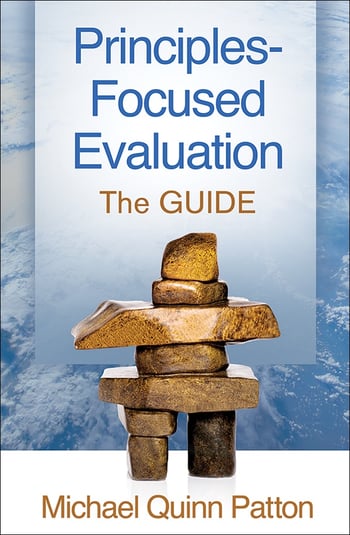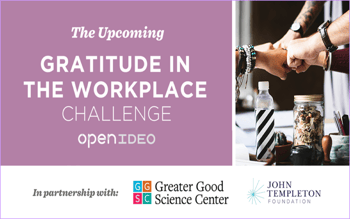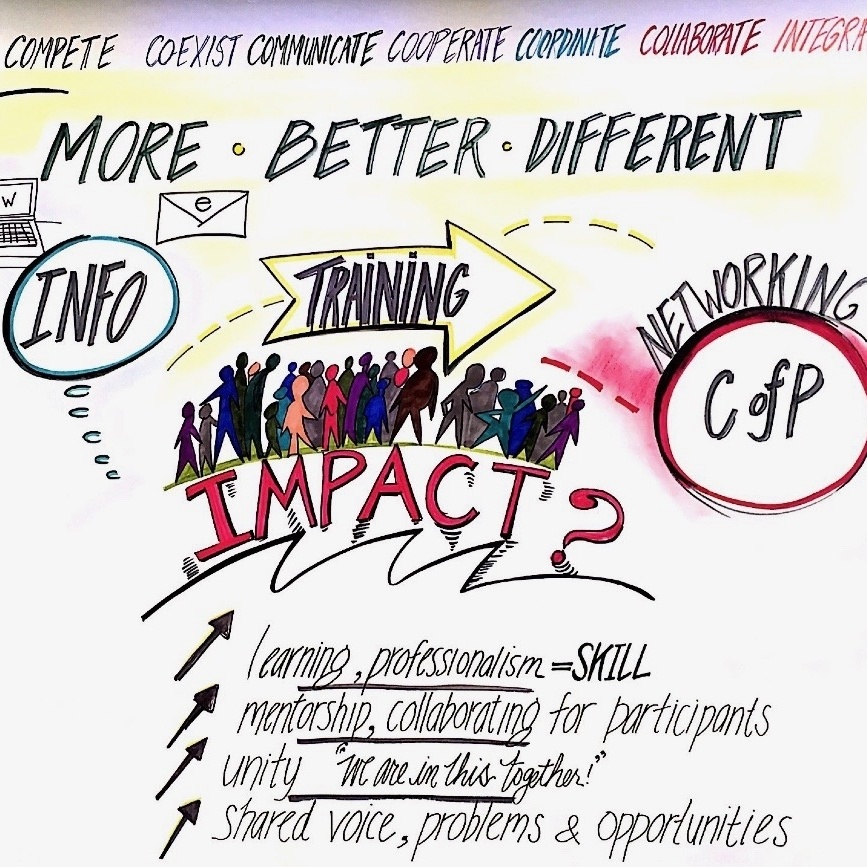Tamarack Institute | December Edition, 2017
In this Issue:
- The Community Innovation Imperative
- Principles-Focused Evaluation: Newest Approach for Evaluating Complex Change Efforts
- Back to the Future: Visual Tools to Help in Sense-making
- The Gratitude in the Workplace Design Challenge
- Leadership for Effective Partnerships
- The Latest from the Field
- Upcoming Events You Won't Want to Miss
The Tamarack Institute wants to wish you, our members, a joy filled holiday season and we look forward to learning together with you in 2018.
 The Community Innovation Imperative
The Community Innovation Imperative
BY: SYLVIA CHEUY
“Any intelligent fool can make things bigger and more complex... It takes a touch of genius and a lot of courage to move in the opposite direction.”
– Ernst F. Schumacher
At Tamarack, we define community Innovation as a particular form of social innovation that is place-based, within the specific geography of a community. Communities are dynamic, “living labs” that offer the perfect container for innovation. Canada has been a pioneer in the field of social innovation, which is defined as “both a destination – the resolution of complex social and environmental challenges – and a journey – devising new approaches that engage all stakeholders, leveraging their competencies and creativity to design novel solutions.” This is knowledge and experience that must be intentionally applied to enhance the well-being of our communities and our nation.
Today, communities are facing an array of complex challenges that the programs we have created have been unable to impact in a significant way. In spite of the dedication and ingenuity of our non-profit, community sector, those who have spent their careers within the sector know, new solutions are required and the results that are urgently needed cannot and will not be found by simply making incremental changes to our current approaches. Working harder alone is not enough. The breakthroughs that community changemakers seek require new approaches.
In our experience in the field of community change, we have come to understand that to be effective, innovations require an appreciation of both the issue one is hoping to address, as well as a deep understanding of the unique characteristics of the community: the place and the people that live within it. Innovations that have proven successful in one community can serve as a source of inspiration for another, but must be adapted and modified if they are to maximize the strengths and assets of the community where they hope to be replicated.
Developing innovation capacity within our communities and non-profit sector has now become a strategic imperative. Research conducted by the Rockefeller Foundation to explore the need for capacity-building in innovation within the not-for-profit sector found that, “80% of non-profit leaders aspire to innovate, but only 40% say their organizations are well set up to do so. At the same time, 50% of non-profit respondents reported that they are experiencing “destabilizing regulatory shocks and policy shifts, at the same time that they are confronting growing competition from other social sector organizations for funding, talent and influence.” It is these conditions that make innovation capacity a requirement rather than an after-thought.
This will require an intentional effort to develop an infrastructure and processes that encourage and support the implementation of innovation. This will include identifying the mindsets, skills, tools, funding and structures to embed and deepen the practice of innovation so we can effectively tackle our communities’ most pressing issues and ensure that all Canadians have the opportunity and support to reach their full potential.
Learn More:
- Read The Community Innovation Imperative
- Connect with Sylvia
- Find more on Community Innovation at tamarackcommunity.ca
Share this article:
 Principles-Focused Evaluation: Newest Approach for Evaluating Complex Change Efforts
Principles-Focused Evaluation: Newest Approach for Evaluating Complex Change Efforts
BY: MARK CABAJ
One of the toughest challenges for social innovators and evaluators is to describe the “it” they are trying to evaluate. While they typically have a general idea of the outcome they would like to see (e.g., an end to homelessness, addressing mental health issues, a feeling of inclusion), they often struggle to lay out the pathway(s) to get there. This makes it difficult for both parties to land on questions, indicators and/or methods around which to build an evaluation design.
Evaluators have tried to help. In the early days, they created “evaluability assessment”, a method for assessing whether the interventions to be evaluated met the conditions required to put together an evaluation, such as clear goals, measures of success, and maps of how their activities would lead to these outcomes. When policy makers and program designers struggled to meet these conditions, evaluators rolled up their sleeves and got into the business of intervention design. Their inventions include logic models, results chains, change pathways, theories of change and – more recently – hypotheses of change.
While each of these tools are useful in specific situations, they have not been able to accommodate a simple yet critical reality that the thinking and action of many would-be change makers are guided by principles rather than logic models. These include:
- Principles that they deem important for the effectiveness of their interventions (e.g., “Housing First”, which means providing vulnerable persons living on the street with housing before anything else);
- Principles that guide the innovator’s efforts when specific designs need to vary from place to place or adapt to an ever-evolving environment (e.g., “Adapt models to reflect local context”); and,
- Principles that reflect deeply held values and beliefs about the proper way to live and behave (e.g., “Nothing about us without us,” which means people with lived experience should be deeply involved in shaping and assessing any intervention that affects their lives).
Yet, for all their power and influence, principles are often implicit. They live in the shadows of social innovation.
In his latest book, Principles-Focused Evaluation: A Guide, Michael Quinn Patton pulls the principles-focused approach out of the shadows and crafts a compelling and coherent approach for integrating them into evaluation practice. The book is organized into five sections:
- Section 1 – Foundations: This section provides an exploration of different types of principles, why they matter, and the niche for principles-focused evaluation in the larger evaluation field.
- Section 2 – Guide: This section reviews the five types of criteria for effective principles.
- Section 3 - Exemplars: This section offers a scan of principles-based interventions guided by principles-focused evaluation.
- Section 4 - Principles for Evaluations and Evaluators: This section reviews issues related to integrating a principles-focused approach into different methods and indicators.
- Section 5 - Tools and Checklists: This section offers a variety of helpful techniques for planning and implementing principles-focused evaluation.
As in all his previous books, Patton illustrates his ideas and practices with an impressive number and variety of anecdotes, vignettes and stories. These focus on different domains (e.g., poverty, homelessness, agriculture, etc.) and operate on different scales (e.g., organizational programs to international). All of them are informative and demonstrate the value of principles-focused evaluation in a wide range of contexts. The Vibrant Communities case study, for example, will be of interest for people interested in poverty reduction, country-wide initiatives, and Canadian examples.
With principles-focused evaluation, Patton has (once again) made a significant contribution to the field of evaluation, as well as to the theory and practice of social innovation. Principles-focused evaluation is a game-changer for social innovators, evaluators, policy makers and funders who are interested in making – and evaluating – progress on the tough economic, social and environmental challenges of our time.
Learn More:
- Buy Principles-Focused Evaluation by Michael Quinn Patton.
- Register here to join Michael Quinn Patton and Mark Cabaj for the webinar, Principles-Focused Evaluation: Newest Approach for Evaluating Complex Change Efforts on Jan 23, 2018, 1:00 – 2:00 pm EST
- Save the dates! This March, Mark Cabaj and Michael Quinn Patton will be teaching an Evaluation Masterclass – Principles-Focused Evaluation for Community Change-Makers in Toronto (March 12), Regina (March 14), Calgary (March 15) and Vancouver (March 16). Keep your eyes peeled in the new year for more details.
- Listen to a past Tamarack webinar with Mark and Michael on Developmental Evaluation: Principles in Practice
Share this article:
 Back to the Future: Visual Tools to Help in Sense-making
Back to the Future: Visual Tools to Help in Sense-making
BY: ERICA DYSON
Hardly a day goes by without my adding a number of smileys to my emails or texts. In fact, here’s one now :) . Why? Well they're so expressive; so much better than LOL or BTW or FYI. So with one small icon, I seem to be able to convey information and feeling.
Icons are being used increasingly to shorten the written word, to liven it up, or to by-pass it. When you go on a website, what do you see? Lots of icons in place of words. They don’t take up much space, and if the icon’s relevant (and not just there for decoration), you immediately ‘get it’. They’re great sign posts and way finders. You get a heads-up of what the text that’s connected to the icon is about. And you get the message quickly and hey, we’re in an instant culture. We need to be able to scan and move on, if the item doesn’t seem of interest, and to hone in on the content that catches our eye.
That’s the power of images and that’s why we use them, not only for PR and marketing but for field work reviews and strategic planning.
Work in community change is complex. There are so many factors that help or hinder change; so many dynamics at work. It’s hard to keep track of them all, and even harder to communicate this to others who are less familiar with your project than you are!
Our experience shows us time and again, that simply talking about a problem or barrier, isn’t really sufficient. Why? Because people start the discussion, not only from different standpoints (that’s natural) but also from different understandings of what they’re trying to achieve collectively. Often what people bring to the table is their emotion, how they feel about someone or something. When this happens, the topic under discussion largely gets buried in the to-ing and fro-ing of agreements or disagreements about what the last person just said.
At other times we turn to evaluation reports to help us get to grips with progress made. A good idea in principle. But there are some weaknesses:
- The reports tend to be long (few read them in full)
- They take a long time to produce and therefore by the time they are published, often the points made are no longer relevant (the project’s moved on)
- The reports are done by an external team. Nothing wrong in that but it often leaves those who are accountable for the delivery feeling dis-engaged and sometimes worse than that, undermined.
- The process is costly and therefore can’t be done very often.
The upshot of this is that all the hard work that went into the evaluation dissipates and those who are left grappling with a mixed bag of operational and strategic conundrums are no further forward.
So neither ‘the in-depth review meetings’ nor the evaluation reports offer enough to those accountable to take practical steps to address questions such as:
- Why are we peddling at full speed but not making the progress we feel we should?
- What’s causing hold-ups in our project?
- How can we turn this juggernaut around?
- Why aren’t x and y involved?
We experienced this dilemma in our work and so we set about creating a set of easy to use, interactive tools to help those engaged in a project get on the same page pretty quickly. And because the tools are interactive, participants see their responses visually, during the meeting, in real time. Within a couple of hours or so, they can get quite a detailed picture of where they, and their project, are at.
We also felt it was important to be able to track process, so we’ve built in the ability to repeat the exercise a number of times. Again the results are visual.
We find that this approach bridges a gap in improving both operational and strategic look forwards. They don’t replace review meetings or external evaluations, rather they enhance them. Indeed, we use them as a tool as part of both of these. They provide a way for participants and stakeholders in a project to ‘get under the skin’ of what people say, feel, and do.
If you saw the film, The Graduate, you might remember that Ben’s parents host a party for him to celebrate his graduation. Ben didn’t want this party, and had no idea what he wanted to do with his life. Of course, there was no shortage of people wanting to give him advice, and ‘help’ him along his way. One great line that has stuck in my mind all these years is this. One of his parents’ friends offers Ben some unsolicited advice: “Ben”, he said, “Plastics. There’s a great future in plastics.”
So I guess, what I wanted to say to you is: “There’s a great future in hieroglyphics.” If you want to know more about our interactive tools, just drop me a line. I’ll be pleased to help :)
Learn More:
- Visit our tools page on the Bridge to the Future website.
- Contact Erica Dyson at ericadyson@gmail.com.
Share this article:
 The Gratitude in the Workplace Design Challenge
The Gratitude in the Workplace Design Challenge
BY: SYLVIA CHEUY
Design Thinking is an essential tool in the community changemaker’s tool-kit. This highly creative “framework for ingenuity” is valued for it’s person-centred focus and its ability to generate innovative solutions tailored to meet their needs.
This Fall, IDEO, the firm credited with creating the human centred design approach, issued the following design challenge: How might we inspire experiences and expressions of gratitude in the workplace?
Liz Weaver, Tamarack’s Co-CEO, took up that challenge and posted a submission entitled "Building "Awesome" Connections - Tamarack Gratitude Fund ” which outlines a practice we established in 2016. Tamarack’s Gratitude Fund works this way: each staff member is allocated $500 which they can use to recognize and express gratitude to teammates as well as our members and partners. One of the fund’s few rules is that no more than 40% of your fund can be spent on internal recognition. To encourage creative use of the fund, each year, the staff member who has made best use of their fund is awarded an additional week of vacation.
Liz identified many benefits to Tamarack’s Gratitude Fund saying, “We learned that in a remote work environment, being able to thank colleagues for their acts of support is also essential. Our members were surprised and pleased with the small gifts of gratitude that were shared. Gratitude Fund gifts build connection, commitment and recognition. It benefited the giver and the receiver. Because we draw on our network of partners, members and staff for support, resources and leadership, being able to recognise their contributions spontaneously is a wonderful tool."
Tamarack’s experience echoes the findings of hundreds of studies of the physical, social and psychological benefits of gratitude. In the workplace, 93% of people agree that grateful bosses are more likely to succeed; 88% of people say expressing gratitude to colleagues makes them happier; and, receiving a thank you from a supervisor has been shown to boost productivity by 50%. However, research has found that, on any given day, only 10% of people say “thank you” to colleagues – and 60% report that they never or very rarely express gratitude at work. The intention behind IDEO’s workplace gratitude design challenge is to “close this ‘gratitude gap’ between what people say they want in the workplace and what they actually do.” The hope is that the challenge will “help identify some of the obstacles to feeling and expressing gratitude at work and to catalyze creative, practical ideas for overcoming these obstacles and inspiring more grateful workplaces.”
The Workplace Gratitude Design Challenge received a total of 347 submissions which were reviewed by OpenIDEO, the Challenge Sponsors and subject-matter experts. Tamarack’s submission was one of 41 submissions that were selected to move on to the challenge’s refinement phase. On December 18th the list of top ideas will be announced. These ideas will share $40,000 in Implementation Grants to support them to deepen and improve the spread of gratitude within their organizations. Cross your fingers!
Learn More:
- Read Tamarack’s Design Submission Building “Awesome” Connections–Tamarack Gratitude Fund
- View IDEO’s Gratitude in the Workplace Design Challenge
- Read The 5 Gratitude Expressions: A Method to Understand & Strengthen the Experience of Gratitude at Work
- Read the Harvard Business Review’s In the Company of Givers and Takers
- Check out the Field-Guide to Human Centered Design at www.tamarackcommunity.ca
Share this article:
 Leadership for Effective Partnerships
Leadership for Effective Partnerships
BY: JOCELYNE DAW
Partnerships and collective impact initiatives are multiplying in Canada, as cross-sectoral collaborators come together to positively advance impact on complex social issues. Partnerships offer the potential for outcomes bigger than any one organization could achieve on their own. Done well, such collaborations enable innovation, create greater value and strengthen commitments from a broader range of people, perspectives and organizations. But success is not always guaranteed. Like anything that delivers great results, collaboration takes hard work, flexibility AND courage. The people involved in making partnerships happen are key to partnering success. How do they build knowledge and skills and possess the tools and insights to deliver positive partnering results?
The Partnership Brokers Association is a global non-profit organization that offers training programs on leading and building effective partnerships. This highly sought after course will be offered in Toronto February 5-8th, 2018. The course provides those working in partnerships with in-depth development to improve and scale multi-stakeholder partnerships and non-traditional collaborations. Participants will receive: tools, techniques and skills development, frameworks and common principles to addresss and overcome barriers.
The course can be used immediately for professional development and real-time partnership building. When partners attend together, they build a common language and framework while developing strategies for the design, management and review of their partnership. This intensive program is limited to 24 participants with two facilitators to maximize potential for exchange, reflection and personal attention to individual leadership.
Learn More:
- Visit the Partnership Brokers Association website
- Learn more and apply for the Toronto Partnership Brokers Training, Feb. 5-8, 2018
- For more on partnerships & collaborative leadership go to: www.tamarackcommunity.ca
Share this article:
PAINTING A PICTURE FROM MANY ANGLES
By: Hailey Hechtman
Read the Post
YOUR IMPACT IN 30 SECONDS!
By: Elayne Greeley
Read the Post
READING THE DIGITAL BODY LANGUAGE OF YOUR COMMUNITY MEMBERS
By: Lisa Attygalle
Read the Post
THE (MOSTLY) CERTITUDES OF CHANGE
By: Tom Klaus
Read the Post
ENDING POVERTY
By: Paul Born
Read the Post
ENHANCING BELONGING: A GUIDEBOOK FOR INDIVIDUALS, ORGANIZATIONS, AND COMMUNITIES
By: John Lord
Read the Post
Principles-Focused Evaluation: Newest Approach to Evaluating Complex Change Efforts
Guest: Michael Quinn Patton
Host: Mark Cabaj
Date: January 23, 2018 | 1:00-2:00 p.m. EST
211: A Tool for Alleviating Poverty






